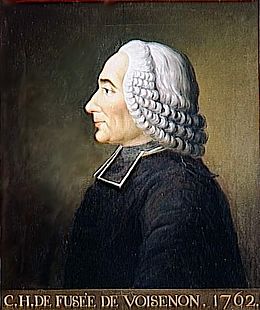CLAUDE-HENRY DE FUSÉE DE VOISENON
Claude-Henry de Fusée, comte de Voisenon (1708-1775), was a French author. He was born in Château de Voisenon near Melun and received a religious education. He was ordained to priesthood in 1739 and became vicar of the diocese of Boulogne. Later he received an income from the convent of Jard, near Melun and dedicated himself to literature. He enjoyed the protection of Madame de Pompadour and Voltaire, through whose intercession he was admitted to the Académie Francaise in 1762. He has left a considerable oeuvre of theatre plays, novels and tales
The fragments:
The tale Le sultan Misapouf et la princesse Grisemine (2 vols., 1746) is a humoristic, rather farcical Oriental tale, clearly fashioned after the example of the Thousand and one nights, but also inspired by the many tales of transformation and carnivalesque adventures of the time (for example the work of Antoine Hamilton). In the Preface the author warns his readers that the story is a little ‘free’, according to the fashion of the time. He wants to profit from this temporary lack of taste to present his story, before the tide turns against it and people will prefer the prudish heroines of the modern novels. He even promises to exaggerate its profligacy to ‘ruin everyone who will hence write in the same vein’. In fact, the story is rather futile. Sultan Misapouf and Sultane Grisemine are conversing about their past, the Sultan saying that at some point he lived in the guise of a fox, whereupon the Sultane suspects him of eating her six children when she was turned into a rabbit. Misapouf starts telling his life story: when he was young he was transformed into a bath tub by the fairy Ténébreuse. He was kidnapped by a queen who needed him to lift the enchantment of her daughter, who was destined to marry a man with a very small finger, which fitted in the ring given to her by the same fairy. Afterwards he was turned into a fox. In the second volume it is Grisemine’s turn to tell her story. The novel’s theme is metamorphosis in various forms, inspired by the vogue of metempsychosis (India) and magic (Thousand and one nights). In this sense it can be compared to the stories of Swift, but it is much more tedious. It is clear, of course, that the novel was meant as a parody of the Oriental tale and the taste for fantastic stories full of supernatural elements.

Sources/references:
Ad. Van Bever/ Charles Martyne (eds.), La vie authentique de M. l’Abbé de Voisenon, mémoires inédits d’un contemporain, Mercure de France, vol. 113, Paris 1916.
Jean Comoy, Un abbé de cour sous Louis XV. Monsieur de Voisenon, La Science Historique, Paris 1959.
Jean de Viguerie, Histoire et dictionnaire du temps des Lumières. 1715-1789, Robert Laffont, Paris 2003.
Dufrenoy, Marie-Louise, L’Orient romanesque en France (1704-1789), 3 vols., Montreal: Beauchemin (vols. 1-2), Amsterdam: Rodopi (vol. 3), 1946-1975.
Martino, Pierre, L’Orient dans la littérature Francaise au XVIIe au XVIIIe siècle, Paris: Librairie Hachette, 1906.
Srinivas Aravamudan, Enlightenment orientalism; resisting the rise of the novel, University of Chicago Press, Chicago/ London 2012.
Weblinks:
http://viaf.org/viaf/21146 (Deutschen Digitalen Bibliothek)
http://www.zeno.org/Literatur/M/Tieck,+Ludwig (Fichier d’Autorité International Virtuel)
http://catalogue.bnf.fr/ark:/12148/cb12003593c (Bibliothèque Nationale de France)
http://www.idref.fr/028142705 (Système Universitaire de Documentation)